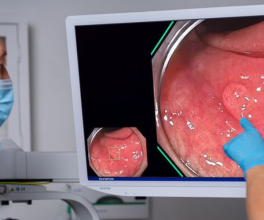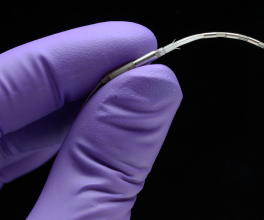
When Little Things are a Big Deal: Olympus’ Investment in Eximis Aims to Keep Incisions Small
Why is it that most minimally invasive surgeries—so-called “keyhole surgeries”— are performed through small incisions, but often require a larger incision to simply remove the specimen?
Eximis Surgical, Inc. (Eximis Surgical) in Boulder, CO, is working on that answer. The company is focused on bridging what they see as a critical gap in minimally invasive procedures – the need for a solution to enable surgeons to remove large, contained specimens through small incisions – so patients can truly benefit from this approach. With a focus to help bring this innovation to market, Olympus Innovation Ventures (OIV), Olympus' venture capital fund, announced its participation in the Series B financing of Eximis Surgical, which raised $8.7 million during the round from Olympus and other investors.
"Olympus is excited to support Eximis Surgical in the development of this promising new technology,” said Nacho Abia, Chief Strategy Officer for Olympus Corporation. “Supporting physicians in elevating the standard of care for patients is a priority for Olympus.”
Minimal history
Within the last 30 years, surgical advances have spanned laparoscopic, thoracoscopic, natural orifice (incisionless) and robotic surgery, with improved visualization of the surgical site. The goal of each of these approaches is to have minimal impact on the patient by keeping the incisions small, and utilizing instruments that can be deployed through ports within these incisions.1
Smaller incisions are intended to benefit the patient by lowering the risk of infection, with the potential for less pain, faster recovery, and reduced hospital stays and related costs – a boon to the healthcare system and the end-goal of patients who want to get back to the lives they love, quicker.2
But specimen removal can sometimes require a larger incision at the end of a minimally invasive procedure.
Containment is key
The Eximis solution has been in the works for over five years and is aimed to:
- Keep a specimen fully contained during segmentation and removal, minimizing chances of tissue leakage;
- Leverage already clinically adopted workflows used with specimen bags;
- Make segmentation and removal of the specimen more efficient;
- Produce regular, clean-cut segments adequate for pathologic assessment; and
- Maintain incision sizes in line with standard and single incision laparoscopic procedures.
With the financing secured through Series B, Eximis Surgical plans to fund U.S. regulatory activities of the Eximis Laparoscopic Specimen Removal System.
“Participation from Olympus, a worldwide leader in minimally invasive surgery, underscores that a clinical need persists for our novel technology,” said Eximis Surgical co-founder and CEO, Donna Ford-Serbu. “We look forward to partnering with [Olympus] to move toward market entry.”
Ford-Serbu is part of a leadership team composed of medical device business leaders, engineers, and sales and marketing strategists that boast a combined 65+ years of medical device experience, with 70+ medical device patents issued and 70+ medical device products launched.
Olympus Innovation Ventures invests in passionate founders looking to revolutionize medical solutions across medical devices, diagnostics, and digital health.
“OIV is designed to support entrepreneurs as they build their businesses in one of the most challenging industries in the world,” said Gabriela Kaynor, Global Division Head of Therapeutic Solutions Division at Olympus. “We are thrilled to invest in the Eximis team as they look to bridge a gap in minimally invasive surgery.”
1. Alkatout I, Mechler U, Mettler L, et al. The Development of Laparoscopy-A Historical Overview. Front Surg. 2021 Dec 15;8:799442.
2. Mattingly AS, Chen MM, Divi V, et al. Minimally Invasive Surgery in the United States, 2022: Understanding Its Value Using New Datasets. J Surg Res. 2023 Jan;281:33-36.





